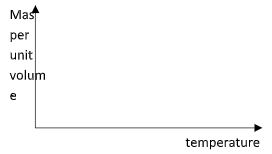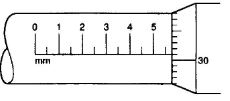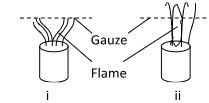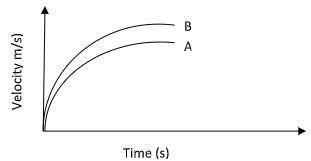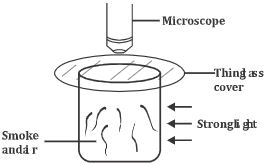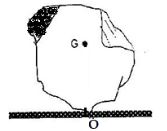Instruction to candidates
- This paper consists of two sections A and B
- Answer all questions in section A and B in the spaces provided
- All workings must be clearly shown, and Use the CONSTANTS given.
- Gravitational acceleration, ‘g’ = 10m/s2
Section A (25 marks)
- Find the total pressure experienced by a diver 8 meters below the sea surface. (3mks)
Take; Atmospheric pressure = 103360N
Density of sea water = 1030 kg/m3 - The figure, 1 below shows an electric heater placed midway between flask A and B. Flask A is shinny on the outside and flask B is blackened on the outside.
Figure 1
- Name the process by which heat travels from heater to the flask. (1mk)
- State the observation that will be made. (1mk)
- Figure, 2 below shows a liquid in a long cylindrical tube closed at one end with a cork. The cork is tight fitting but movable.
Figure 2
State and explain the observation that would be made when the tube is heated uniformly.(2mks) - State and explain the type of equilibrium represented by the marble in the figure 3, below (2 marks)
Figure 3
- The diagram below (figure 4) shows a model of fire alarm which was made by a form one student. The compound bar is made of brass and iron.
Figure 4
When the bar is heated with a candle flame the bell rings. Explain. (2 marks) - Sketch on the axes provided a graph to show how mass per unit volume of water varies with temperature when water is heated from 0° to 20° (2mks)
- A student used the micrometer screw gauge shown below to measure the diameter of a cylindrical object
Using the diagram determine the diameter of the cylindrical object (1 mark) - When a Bunsen burner is lit below wire gauze, it is noted the flame initially burns below the gauze as shown in (i). After sometime, the flame burns below as well as above the gauze as shown in (ii).
Explain this observation (2mks) - The figure 7, shows the velocity time graph of two identical spheres released from the surfaces of two liquids A and B.
Give a reason why the terminal velocity of the sphere in B is higher than in A. (1mk) - State how the velocity of a moving fluid varies with pressure. (1mk)
- A spring of length 6 cm is stretched to a length of 8.5 cm by a force of 5 N. Calculate the energy stored by the spring. (2 marks)
- Other than oil patch being monolayer, sate any one other assumption in the oil drop experiment. (1mark)
- State how heat losses by convection and radiation are minimized in a thermos flask. (2mks)
- A box of mass 500g is dragged along a level ground at a speed of 12m/s. if the force of friction between the box and the floor is 2000N, calculate the power developed. (2mks)
Section B (55 marks) -
- State what is meant by an ideal gas. (1mk)
- The pressure acting on a gas in a container was changed steadily while the temperature of the gas was maintained constant. The value of volume (v) of gas was measured for various value of pressure (p). The graph in the figure below shows the relationship between the pressure (p) and the reciprocal of volume (v).
Figure 8
- Suggest how the temperature of the gas could be kept constant. (1mk)
- Given that the relationship between pressure (p) and volume (v) of the gas is given by pv = k whereby k is a constant, use the graph to determine the value of k. (3mks)
- What physical quantity does k represent? (1mk)
- State one precaution you would take when performing such an experiment. (1mk)
- A gas occupies a volume of 4000 litres at a temperature of 37°c and normal atmospheric pressure. Determine the new volume of the gas if it is heated at a constant pressure to a temperature of 67°c. (Normal atmospheric pressure = 1.01 x105pa) (4mks)
-
- State the principle of conservation of linear momentum. (1mk)
- Distinguish between elastic and inelastic collision. (1mk)
- A sticker kicks a ball of mass 200 g initially at rest with a force of 78N. Given that the foot was in contact with the ball for 0.30s, determine the take – off velocity of the ball. (3mks)
- A high jumper usually lands on a thick soft mattress. Explain how the mattress helps in reducing the force of impact. (2mks)
- A ball is thrown horizontally from the top of a vertical tower of height 75m and strikes the ground at a point of 80m from the bottom of the tower.
Determine the:- Time taken by the ball to hit the ground (acceleration due to gravity= 10m/s) (3 marks)
- Initial horizontal velocity of the ball. (2mks)
-
- Explain why water is a good coolant liquid in a car engine cooling system (1mks)
- What is meant by the term specific latent heat of vaporization (1mks)
- Water of mass 5000g initially at 18°C is heated in an electric kettle rated 2.5 KW. The water is heated until it boils at 98°C taking specific heat capacity of water to be 4,200 JKg-11k-1, heat capacity of kettle as 438 Jkg-1, specific latent heat of vaporization of water to be 2.28MJkg1-1calculate
- The heat absorbed by the water (2mks)
- The heat absorbed by the electric kettle. (2mks)
- The time taken for the water to boil (2mks)
- How much longer it will take to boil away all the water into vapour (2mks)
- Brownian motion of smoke particles can be studied by using the apparatus shown in figure, 9 below. To observe the motion, some smoke is closed in the smoke cell and then observe through the microscope.
- Explain the role of the smoke particles and microscope in the experiment.
- Smoke particles (1 mark)
- Microscope (1 mark)
- Why are smoke particles suitable for use in this experiment? (2 marks)
- State and explain the nature of the observed motion of the smoke particles. (2 marks)
- What will be observed about the motion of the smoke particles if the temperature surrounding the smoke cell is lowered slightly. (1 mark)
- Explain why an air bubble increase in volume as it rises from the bottom of a lake to the surface. (2 marks)
- The diagram in figure, 10 below shows a section of a pipe with different cross-sectional area.
If water flows with a velocity of 10m/s in section A, what would be the velocity of water in section B? (3 marks)
- Explain the role of the smoke particles and microscope in the experiment.
- The figure 11, below represents a rock balanced at point O. G is the center of gravity of the rock. Use this information to answer the following questions:
- Draw and label on the figure the forces acting on the rock (2 marks)
- If the portion of the rock represented by the shaded part is chopped off, explain why the rock may topple to the right. (2 marks)
- An astronaut is on the moon. He drops a hammer from a height of 3.2m and it takes 2.0s to hit the lunar landscape. What is the acceleration due to gravity of the moon? (3 marks)
- Give a reason why water is not a suitable liquid for use in a barometer (1 mark)
- Name two types of forces which can act between objects without contact. (2 marks)
MARKING SCHEME
Instruction to candidates
- This paper consists of two sections A and B
- Answer all questions in section A and B in the spaces provided
- All workings must be clearly shown, and Use the CONSTANTS given.
- Gravitational acceleration, ‘g’ = 10m/s2
Section A (25 marks)
- Find the total pressure experienced by a diver 8 meters below the sea surface. (3mks)
Take; Atmospheric pressure = 103360N
Density of sea water = 1030 kg/m3
Pressure experienced by diver = Atmospheric pressure + Pressure due to sea water
= 103360 + ρgh
= 103360 + 1030 x 10 x 8
= 185,760 N/m2 - The figure, 1 below shows an electric heater placed midway between flask A and B. flask A is shinny on the outside and flask B is blackened on the outside.
Figure 1
- Name the process by which heat travels from heater to the flask. (1mk)
- Radiation
- State the observation that will be made. (1mk)
- Level of the liquid in Y decreases and level of liquid in x rises.
- Name the process by which heat travels from heater to the flask. (1mk)
- Figure, 2 below shows a liquid in a long cylindrical tube closed at one end with a cork. The cork is tight fitting but movable.
Figure 2
State and explain the observation that would be made when the tube is heated uniformly. (2mks)- The tube tilt in anticlockwise direction.; The liquid moves towards left pushing the cork resulting to anticlockwise moment being greater than clockwise moment.;
- State and explain the type of equilibrium represented by the marble in the figure 3, below (2 marks)
Figure 3
- Unstable; a small force on the object causes it to topple over.
- The diagram below (figure 4) shows a model of fire alarm which was made by a form one student. The compound bar is made of brass and iron.
Figure 4
When the bar is heated with a candle flame the bell rings. Explain. (2 marks)- On heating, brass expands more than iron; this causes the bimetallic to bend and closes the gap with the contact hence the bell rings.
- Sketch on the axes provided a graph to show how mass per unit volume of water varies with temperature when water is heated from 0° to 20°(2mks)
- A student used the micrometer screw gauge shown in figure 5 to measure the diameter of a cylindrical object
Using the diagram determine the diameter of the cylindrical object (1 mark)- 5.81mm
- When a Bunsen burner is lit below wire gauze, it is noted the flame initially burns below the gauze as shown in (i). After sometime, the flame burns below as well as above the gauze as shown in (ii).
Explain this observation (2mks)- Initially the air above the graze has not reached the ignition temperatures after sometime the heat from the graze raises the temperature above it to its ignition temperature.
- The figure 7, shows the velocity time graph of two identical spheres released from the surfaces of two liquids A and B.
Give a reason why the terminal velocity of the sphere in B is higher than in A. (1mk)- Fluid B is less viscous compared to A or A is more viscous than fluid B
- State how the velocity of a moving fluid varies with pressure. (1mk)
- Increase in velocity of moving fluid is accompanied by a decrease in pressure
- A spring of length 6 cm is stretched to a length of 8.5 cm by a force of 5 N. Calculate the energy stored by the spring. (2 marks)
- E= ½ Fe = ½×5×0.025 = 0.0625J
- Other than oil patch being monolayer, sate any one other assumption in the oil drop experiment. (1mark)
- The molecules in oil patch are closely packed.
- The oil drop is a perfect sphere/the oil patch perfect circular.
- State how heat losses by convection and radiation are minimized in a thermos flask. (2mks)
- Convection minimized by having a vacuum between double walls
- Radiation is minimized by shinny/ silvery walls
- A box of mass 500g is dragged along a level ground at a speed of 12m/s. if the force of friction between the box and the floor is 2000N, calculate the power developed. (2mks)
- P = Fv ; 2000 x 12 = 24000W
Section B (55 marks)
- P = Fv ; 2000 x 12 = 24000W
-
- State what is meant by an ideal gas. (1mk)
- Gas that obeys all gas√ laws perfectly.
- The pressure acting on a gas in a container was changed steadily while the temperature of the gas was maintained constant. The value of volume (v) of gas was measured for various value of pressure (p). The graph in the figure below shows the relationship between the pressure (p) and the reciprocal of volume (v).
Figure 8
- Suggest how the temperature of the gas could be kept constant. (1mk)
- By changing pressure slowly√ or allowing gas to go back to the original temperature after the change.
- Given that the relationship between pressure (p) and volume (v) of the gas is given by pv = k whereby k is a constant, use the graph to determine the value of k. (3mks)
K = slope√
(0, 0) and (4.0 x 106, 3.25 x 105)
K = y = 3.25 x 105- -0
4.0 x106-0
= 0.081125 NM. - What physical quantity does k represent? (1mk)
- Work done on compressing the gas.
- State one precaution you would take when performing such an experiment. (1mk)
- Dry gas should be used.
- Make small changes in temperature.
- Suggest how the temperature of the gas could be kept constant. (1mk)
- A gas occupies a volume of 4000 litres at a temperature of 370c and normal atmospheric pressure. Determine the new volume of the gas if it is heated at a constant pressure to a temperature of 670c. (Normal atmospheric pressure = 1.01 x105pa) (4mks)
V1 = V2√ OR P1V1 = P2V2 whereby P1 = P2
T1 T2 T1 T2
= V2 = V1T2
T1
T1 = 37 + 273 = 310K.√
T2 = 67+ 273 = 340K.
= 400 x 340
310√
= 4387.1 liters √
- State what is meant by an ideal gas. (1mk)
-
- State the principle of conservation of linear momentum. (1mk)
- For a system of colliding bodies, the total linear momentum remains constant provided no√ external forces act.
- Distinguish between elastic and inelastic collision. (1mk)
- Elastic collision on occurrence both momentum and kinetic energy are conserved while in elastic collision on occurrence only momentum√ is conserved.
- A sticker kicks a ball of mass 200 g initially at rest with a force of 78N. Given that the foot was in contact with the ball for 0.30s, determine the take – off velocity of the ball. (3mks)
Ft = m (v − u) √
=78 x 0.30 = 0.2 (v-0)√
= 0.2v = 78 x 0.3
0.2 0.2
V = 117m/s√ - A high jumper usually lands on a thick soft mattress. Explain how the mattress helps in reducing the force of impact. (2mks)
- The thick soft mattress increases the stopping√ time which reduces the rate of change√ of momentum.
- A ball is thrown horizontally from the top of a vertical tower of height 75m and strikes the ground at a point of 80m from the bottom of the tower.
Determine the:- Time taken by the ball to hit the ground (acceleration due to gravity= 10m/s) (3 marks)
S = ut + ½ gt2
75 = 0xt +1/2 x 10t2
T2 = 15√
T = 15
= 3.873s√ - Initial horizontal velocity of the ball. (2mks)
R = ut
80 = u x 3.873
U = 80
15√
= 20.66m/s√
- Time taken by the ball to hit the ground (acceleration due to gravity= 10m/s) (3 marks)
- State the principle of conservation of linear momentum. (1mk)
-
- Explain why water is a good coolant liquid in a car engine cooling system (1mks)
- Water has a high specific head capacity
- What is meant by the term specific latent heat of vaporization (1mks)
- It is the heat required to change a unit mass of a substance from liquid to vapour without a change in temperature.
- Water of mass 5000g initially at 18°C is heated in an electric kettle rated 2.5 KW. The water is heated until it boils at 98°c taking specific heat capacity of water to be 4,200 JKg-1k-1, heat capacity of kettle as 438 Jkg-1, specific latent heat of vaporization of water to be 2.28MJkg1-1calculate
- The heat absorbed by the water (2mks)
q = Mw Cw Dⱷ
= 5 x 4200 x (98 – 18)
= 1680 000 - The heat absorbed by the electric kettle. (2mks)
Q = power x time = (2.5 x 1000) t
= 2500t J - The time taken for the water to boil (2mks)
heat supplied by kettle = heat gained by water
2500t = 1680 000
T= 1680 000
2500
= 672 seconds - How much longer it will take to boil away all the water into vapour (2mks)
heat supplied by kettle = heat gained to evaporate
Power x time = mlv
2500l = 5x 2.28 x 106
T = 4560 seconds
- The heat absorbed by the water (2mks)
- Explain why water is a good coolant liquid in a car engine cooling system (1mks)
- Brownian motion of smoke particles can be studied by using the apparatus shown in figure, 9 below. To observe the motion, some smoke is closed in the smoke cell and then observe through the microscope.
- Explain the role of the smoke particles and microscope in the experiment.
- Smoke particles (1 mark)
- For visibility of air movement
- Microscope (1 mark)
- Magnification of smoke particles
- Smoke particles (1 mark)
- Why are smoke particles suitable for use in this experiment? (2 marks)
- Smoke particles are light and big; enough hence easily knocked off by invisible air particles;
- State and explain the nature of the observed motion of the smoke particles. (2 marks)
- Smoke particles observed move randomly;
- They move at random due to bombardment with air molecules which move randomly
- What will be observed about the motion of the smoke particles if the temperature surrounding the smoke cell is lowered slightly. (1 mark)
- The smoke particles movement is less vigorous
- Explain why an air bubble increase in volume as it rises from the bottom of a lake to the surface. (2 marks)
- Pressure in liquids increases with depth; The pressure due to water acting on the bubble decreases as the bubble rises
- The diagram in figure, 10 below shows a section of a pipe with different cross-sectional area.
If water flows with a velocity of 10m/s in section A, what would be the velocity of water in section B? (3 marks)
A1V1 = A2V2
48 x 10-4 x 10 = 12 x 10-4V2 ü1
V2 = 48 x 10
12
= 40m/s
- Explain the role of the smoke particles and microscope in the experiment.
- The figure 11, below represents a rock balanced at point O. G is the center of gravity of the rock. Use this information to answer the following questions:
- Draw and label on the figure the forces acting on the rock (2 marks)
- If the portion of the rock represented by the shaded part is chopped off, explain why the rock may topple to the right. (2 marks)
- Anticlockwise moment is reduced hence the clockwise moment becomes relatively more.
- An astronaut is on the moon. He drops a hammer from a height of 3.2m and it takes 2.0s to hit the lunar landscape. What is the acceleration due to gravity of the moon? (3 marks)
s = ut + ½gt2
3.2 = 0 + ½g(22)≡ g = 3.22 = 1.6m/s2 - Give a reason why water is not a suitable liquid for use in a barometer (1 mark)
- Very low density hence, a very big column required
- Name two types of forces which can act between objects without contact. (2 marks)
- Magnetic, electrostatic and gravitational.
Download Physics Paper 1 Questions and Answers - Form 3 End Term 3 Exams 2023.
Tap Here to Download for 50/-
Get on WhatsApp for 50/-
Why download?
- ✔ To read offline at any time.
- ✔ To Print at your convenience
- ✔ Share Easily with Friends / Students

